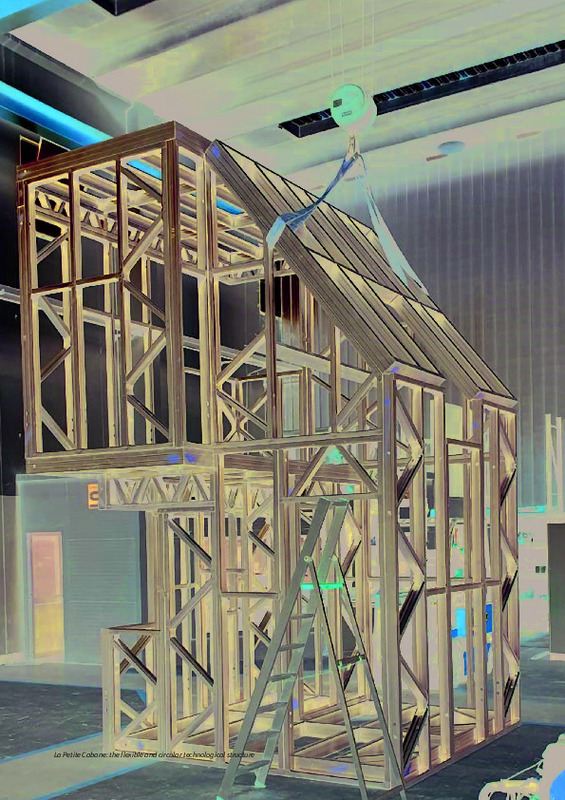Ajayi, S.O., Oyedele, L.O., Bilal, M., Akinade, O.O., Alaka, H.A., Owolabi, H.A. 2017. ‘Attributes of design for construction waste minimization: a case study of wasteto-energy.’ Renew. Sustain. Energy Rev., 73, 1333e1341. https://doi.org/10.1016/j.rser.2017.01.084
Akanbi, L. A., Oyedele, L. O., Omoteso, K., Bilal, M., Akinade, O. O., Ajayi, A. O., Davila Delgado, J. M., Owolabi H. A. 2019. ‘Disassembly and deconstruction analytics system (D-DAS) for construction in a circular economy.’ Journal of Cleaner Production, 223, 2019, Pages 386-396, https://doi.org/10.1016/j.jclepro.2019.03.172
Akinade, O.O., Oyedele, L.O., Ajayi, S.O., Bilal, M., Alaka, H.A., Owolabi, H.A., Bello, S.A., Jaiyeoba, B.E., Kadiri, K.O. 2017. ‘Design for Deconstruction (DfD): Critical success factors for diverting end-of-life waste from landfills.’ Waste Manag., 60, 3–13. https://doi.org/10.1016/j.wasman.2016.08.017
[+]
Ajayi, S.O., Oyedele, L.O., Bilal, M., Akinade, O.O., Alaka, H.A., Owolabi, H.A. 2017. ‘Attributes of design for construction waste minimization: a case study of wasteto-energy.’ Renew. Sustain. Energy Rev., 73, 1333e1341. https://doi.org/10.1016/j.rser.2017.01.084
Akanbi, L. A., Oyedele, L. O., Omoteso, K., Bilal, M., Akinade, O. O., Ajayi, A. O., Davila Delgado, J. M., Owolabi H. A. 2019. ‘Disassembly and deconstruction analytics system (D-DAS) for construction in a circular economy.’ Journal of Cleaner Production, 223, 2019, Pages 386-396, https://doi.org/10.1016/j.jclepro.2019.03.172
Akinade, O.O., Oyedele, L.O., Ajayi, S.O., Bilal, M., Alaka, H.A., Owolabi, H.A., Bello, S.A., Jaiyeoba, B.E., Kadiri, K.O. 2017. ‘Design for Deconstruction (DfD): Critical success factors for diverting end-of-life waste from landfills.’ Waste Manag., 60, 3–13. https://doi.org/10.1016/j.wasman.2016.08.017
Attia, S. 2018. Regenerative and Positive Impact Architecture: Learning from Case Studies, Springer, Liege, Belgium, pp. 33-45. https://doi.org/10.1007/978-3-319-66718-8_5
Brownell, B. 2018. ‘The aesthetics of green: material expression in sustainable architecture.’ TECHNE - Journal of Technology for Architecture and Environment, 16, 20-28. https://doi.org/10.13128/Techne-23996
Cellucci, C., Di Sivo, M. 2014. ‘Strategie per la flessibilità spaziale e tecnologica.’ TECH–E - Rivista di Tecnologia pe’ l’Architettura ’ l’Ambiente, 8, 271-277. https://doi.org/10.13128/Techne-15082
Cruz Rios, F., Chong, W. K., Grau. D. 2015. ‘Design for disassembly and deconstruction-challenges and opportunities.’ Procedia Eng. 118 (Jan): 1296–1304. https://doi.org/10.1016/j.proeng.2015.08.485.
D’Amico, B., Pomponi, F. 2018. Sustainability tool to optimise material quantities of steel in the construction industry, 25th CIRP Life Cycle Engineering (LCE) Conference, 30 April – 2 May 2018, Copenhagen, Denmark, Procedia CIRP 69 184 – 188. https://doi.org/10.1016/j. procir.2017.10.006
De Wolf, C., Pomponi, F., Moncaster, A. 2017. ‘Measuring embodied carbon dioxide equivalent of buildings: A review and critique of current industry practice.’ Energy and Buildings, 140, pp. 68-80. https://doi.org/10.1016/j.enbuild.2017.01.075
Ekanayake, L.L., Ofori, G. 2004. ‘Building waste assessment score: design-based tool.’ Build. Environ. 39, 851e861. https://doi.org/10.1016/j.buildenv.2004.01.007
Ferreira Silva, M. 2020. Another way of living: The Prefabrication and modularity toward circularity in the architecture, BEYOND 2020 – World Sustainable Built Environment conference IOP Conf. Series: Earth and Environmental Science 588 (2020) 042048 IOP Publishing, https://doi.org/10.1088/1755-1315/588/4/042048
Ferreira Silva, M., Jayasinghe, L.B., Waldmann, D., Hertweck, F. 2020. Recyclable Architecture: Prefabricated and Recyclable Typologies. Sustainability, 12, 1342. https://doi.org/10.3390/su12041342
Finch, G., Marriage, G. 2019. ‘Eliminating Building and Construction Waste with Computer-Aided Manufacturing and Prefabrication.’ In: Mutis, I., Hartmann, T. (eds) Advances in Informatics and Computing in Civil and Construction Engineering. Springer, Cham. https://doi.org/10.1007/978-3-030-00220-6_97
Florentin, Y., Pearlmutter, D., Givoni, B., Gal, E. 2017. A life-cycle energy and carbon analysis of hemp-lime bio-composite building materials, Energy and Building, 156, 293-305, https://doi.org/10.1016/j.enbuild.2017.09.097
Gardner, H. 1996. Intelligence Reframed. Libri di base ed., NY, USA.
Gelderman, R.J. 2016. ‘Design for Change and Circularity – Accommodating Circular Material & Product Flows in Construction’, Energy Procedia, 96, 301-311, https://doi.org/10.1016/j.egypro.2016.09.153
Kanters, J. 2018. ‘Design for Deconstruction in the Design Process: State of the Art.’ Buildings 2018, 8, 150; doi:10.3390/buildings8110150
Lozano, D., Martín, Á., Serrano, M. A., López-Colina, C. 2019.’Design of Flexible Structural System for Building Customization.’ Advances in Civil Engineering, 2019, 2103830. https://doi.org/10.1155/2019/2103830
Luther, M., Altomonte, S. and Coulson, J. 2006. Towards a renewable adaptive recyclable and environmental architecture, in ANZAScA 2006: Challenges for architectural science in changing climates: proceedings of the 40th Annual Conference of the Architectural Science Association, School of Architecture, Landscape Architecture and Urban Design, University of Adelaide and Architectural Science Association, Adelaide, S. Aust., pp. 270-278.
Mang, P., Reed, B. 2020. ‘Regenerative Development and Design.’ In: Loftness, V. (ed.) Sustainable Built Environments, pp.115-141 doi:10.1007/978-1-0716-0684-1_303
McDonough, W., Braungart, M. 2010. Cradle to Cradle: Remaking the way we make things. North Point Press, Farrar, Straus and Giroux, NY, USA.
Ramos-Carranza, A., Añón-Abajas, R. M., Rivero-Lamela, G. 2021. ‘A Research Methodology for Mitigating Climate Change in the Restoration of Buildings: Rehabilitation Strategies and Low-Impact Prefabrication in the “El Rodezno” Water Mill.’ Sustainability, 13(16), 8869. https://doi.org/10.3390/su13168869
Verhagen, Teun, Cetinay, Hale, Voet, Ester, Sprecher, Benjamin. 2022. Transitioning to Low-Carbon Residential Heating: The Impacts of Material-Related Emissions. Environmental Science & Technology, 56(12), 8561–8570. https://doi.org/10.1021/acs.est.1c06362
Violano, A., Cannaviello, M. 2021. ‘The communicative force of a prototype: testing technological design research in architecture’ In: Proceedings of INTED2021 Conference, 8th-9th March 2021. https://doi.org/10.21125/inted.2021.0176
Violano, A., Cannaviello, M. 2022. ‘Bio-based thinking: ricerca e innovazione sui materiali carbon-zero per la circular economy.’ In: Ferrante, T., Tucci, F., BASES - Benessere, Ambiente, Sostenibilità, Energia, Salute. Programmare e progettare nella transizione, pp. 387-395. Franco Angelo Editore, Milano
Violano, A., Cannaviello, M., Del Prete, S. 2021. ‘Bio-based circular materials. Innovative packaging and construction product.’ AGATHÓN | International Journal of Architecture, Art and Design, 9(online), pp. 244-253. https://doi.org/10.19229/2464-9309/9242021
Violano, A., Capobianco, L., Cannaviello, M. 2021. ‘Il futuro adesso: un edificio prefabbricato adattivo su misura a energia zero.’ TECHNE - Journal of Technology for Architecture and Environment, (2), 122-127. https://doi.org/10.13128/techne-10695
[-]









